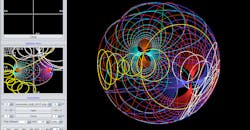The Smith Chart Enters a New Dimension (.PDF Download)
The Smith chart, which is unquestionably one of the most important and fundamental aspects of microwave engineering, has a long history that spans more than 70 years. However, one team of engineers decided to take the classical Smith chart and put a much different spin on it. The result is a 3D Smith chart tool, which the team says is a new vision in microwave analysis and design (see figure).
The 3D Smith chart tool is an easy-to-install 3D representation of the classical Smith chart that is intended for high-frequency one- and two-port circuits. It works for all passive and active circuits—even when negative resistance is present. With this tool, users can observe impedance/admittance, as well as stability circles, group delay, quality factor, and unilateral power gain.
The 3D Smith chart differs from the traditional Smith chart in a number of ways. For example, as most already know, the center of the classical Smith chart denotes a perfect match. However, the 3D Smith chart shows a perfect match at the north pole.
